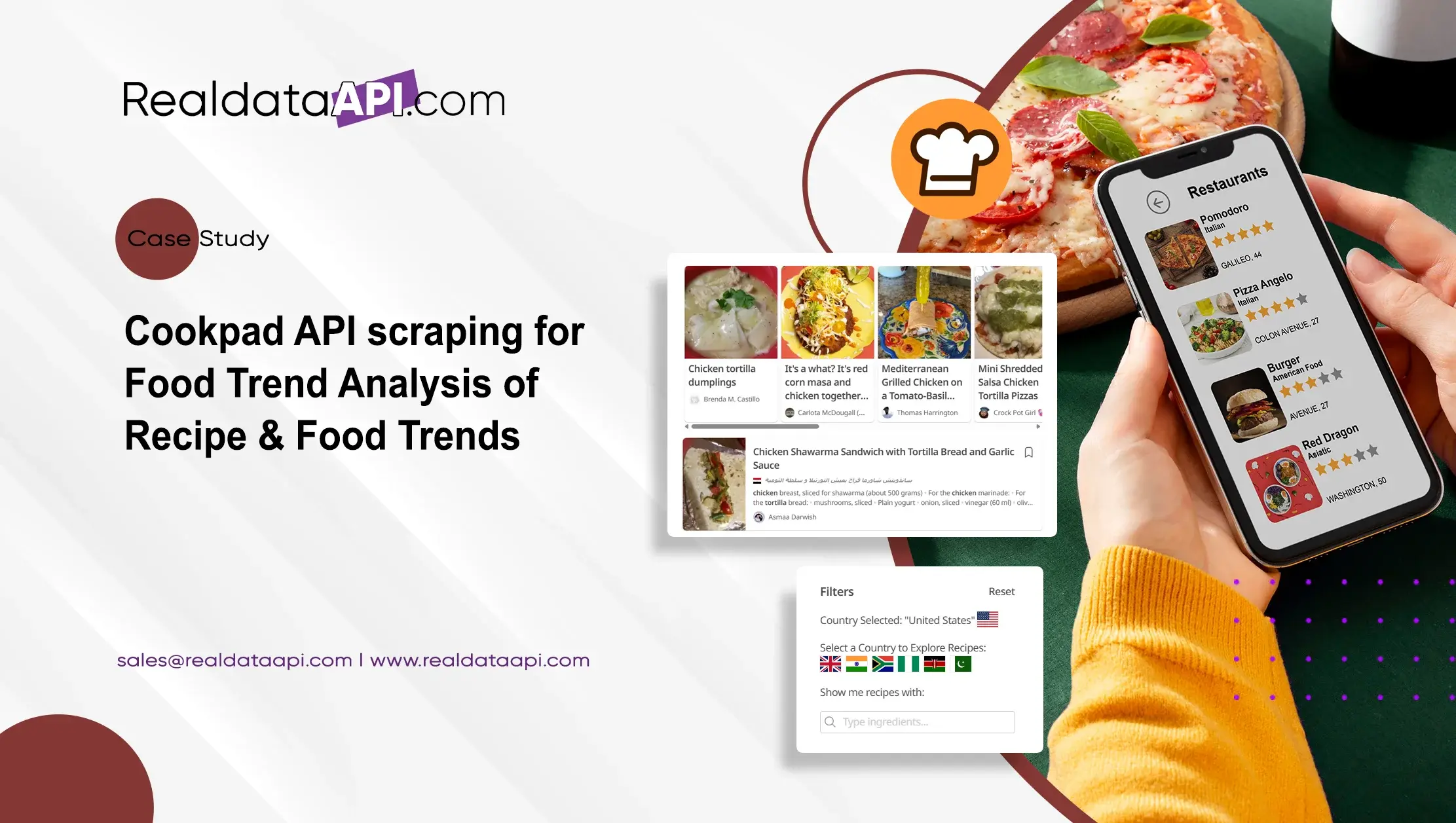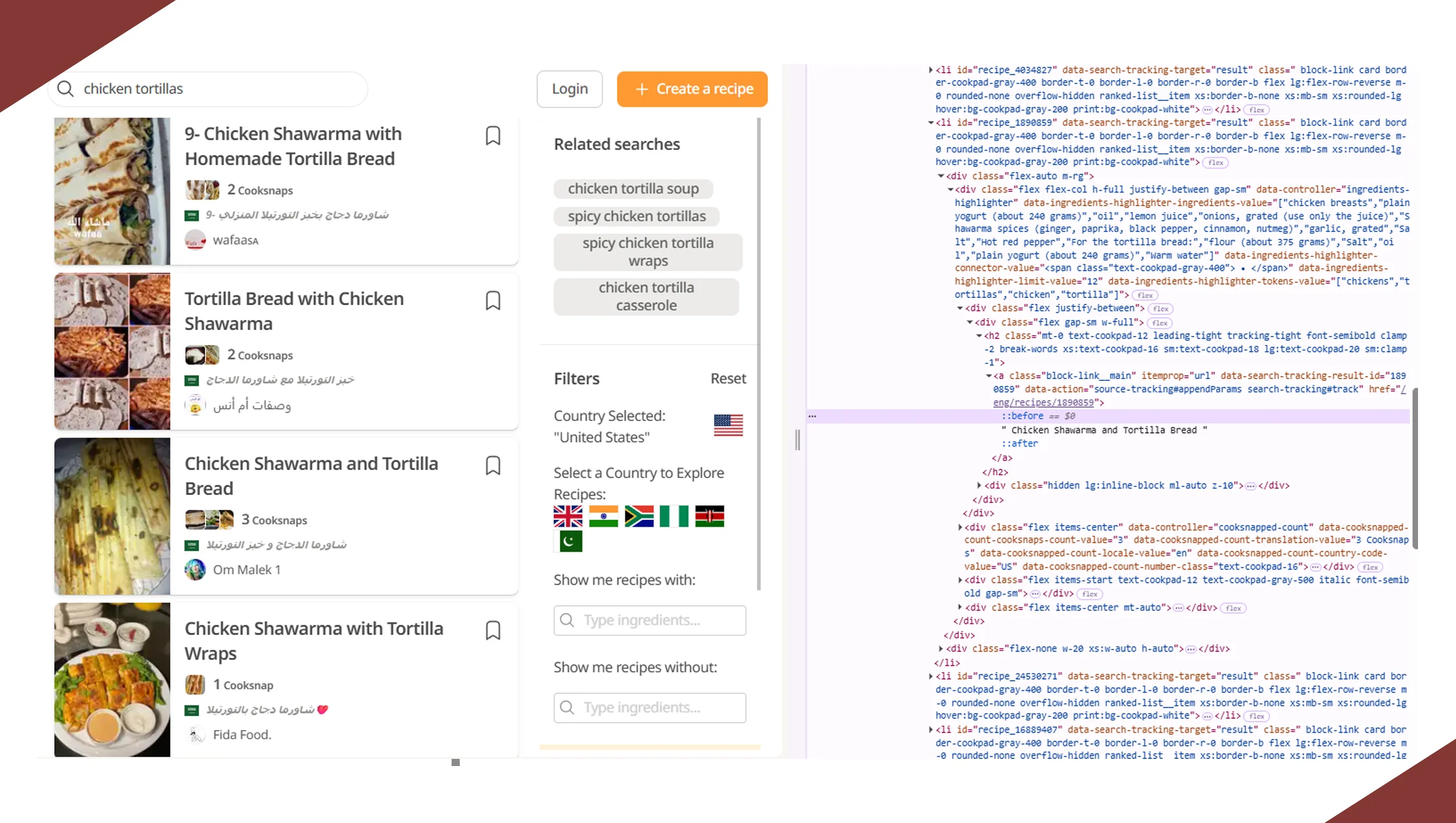
Introduction
The culinary landscape is rapidly evolving, with new recipes and food trends emerging daily. For food brands, restaurants, and culinary platforms, understanding these trends is crucial to staying relevant and competitive. Cookpad API scraping for Food Trend Analysis provides a reliable solution by systematically collecting recipe and ingredient data, uncovering emerging dishes, and offering actionable insights for product development and marketing strategies.
Realdata API leveraged Extract recipe and ingredient data from Cookpad to provide clients with structured datasets of trending recipes, ingredient popularity, and seasonal culinary patterns. By integrating real-time analytics, businesses could monitor shifts in consumer preferences, optimize menu offerings, and anticipate trends before competitors. This case study illustrates how our solution enabled effective decision-making through comprehensive Cookpad API scraping for Food Trend Analysis, turning raw culinary data into strategic intelligence for growth and innovation in the food industry.
The Client

The client was a multinational food brand seeking to expand its product line and menu offerings in alignment with emerging culinary trends. With a focus on both home cooking and delivery-ready recipes, the client needed insights into popular dishes, trending ingredients, and seasonal preferences.
Traditional market research and social listening methods provided limited data, often outdated by the time insights were actionable. The client partnered with Realdata API to implement Cookpad data scraper API, enabling automated extraction of structured recipe data from Cookpad. By using scrape recipes from Cookpad for analytics, the client gained access to a rich dataset of recipes, cooking patterns, and ingredient usage, empowering them to forecast trends and refine product innovation strategies effectively.
Key Challenges

The first challenge was the sheer volume and velocity of recipe uploads on Cookpad. Thousands of new recipes appear daily, making manual tracking impossible and delaying insights into emerging trends.
Data structure inconsistencies also posed a challenge. Recipes include multiple ingredients, varying cooking methods, and different categorizations that required normalization for analytics. The client needed a solution to standardize these datasets for meaningful trend analysis.
Additionally, real-time insights were crucial. Without automated collection, the client risked missing seasonal trends or viral recipes that could inform product launches and marketing campaigns. Ensuring data accuracy, avoiding duplication, and maintaining compliance with Cookpad's usage policies were also significant concerns.
Finally, integrating recipe and ingredient data into the client's existing analytics platform required robust Web Scraping Cookpad food recipes techniques and scalable solutions to provide timely, actionable intelligence on culinary trends, enabling data-driven decision-making.
Key Solutions

Realdata API implemented a robust Cookpad API scraping for Food Trend Analysis solution, leveraging automated pipelines to extract and structure recipe and ingredient data. Using Cookpad recipe dataset, the platform captured key metrics, including ingredient frequency, recipe popularity, and user engagement, providing a comprehensive view of trending dishes.
The solution employed Cookpad Delivery API to cross-reference recipes with delivery-ready formats, helping the client identify dishes suitable for commercial rollout and menu optimization. Automated Food Dataset generation allowed the client to analyze seasonal trends, regional preferences, and emerging dietary patterns.
To ensure scalability, we implemented Web Scraping API technology capable of processing thousands of recipes daily while maintaining compliance and accuracy. The client could also Extract recipe and ingredient data from Cookpad to detect early signals of viral dishes and adapt marketing and product development strategies in real time.
Additionally, our platform allowed the client to scrape recipes from Cookpad for analytics, combining historical and real-time insights into a unified dashboard. By leveraging these datasets, the client could anticipate culinary trends, optimize ingredient sourcing, and innovate with confidence, ensuring their offerings resonated with evolving consumer tastes.
This fully automated, accurate, and scalable approach transformed raw Cookpad data into actionable business intelligence.
Client Testimonial

“Realdata API has been a game-changer for our culinary analytics. Through Cookpad API scraping for Food Trend Analysis, we now monitor trending recipes and ingredient patterns in real time. The insights from the Cookpad recipe dataset and automated scrape recipes from Cookpad for analytics have allowed us to innovate faster, optimize our menu offerings, and anticipate consumer preferences with confidence. Their platform is accurate, scalable, and seamlessly integrated into our analytics workflows, enabling data-driven decisions that directly impact our product development and marketing strategies.”
— Head of Product Innovation, Global Food Brand
Conclusion
In today’s fast-evolving culinary market, timely insights into recipes, ingredients, and food trends are critical for success. Realdata API enabled the client to implement Cookpad API scraping for Food Trend Analysis, providing structured, real-time datasets that transformed raw Cookpad data into actionable intelligence.
By leveraging Web Scraping Cookpad food recipes, the client gained visibility into trending dishes, ingredient popularity, and seasonal patterns, while the Cookpad Delivery API integration allowed alignment with delivery-ready products. The platform’s automation, scalability, and accuracy ensured continuous monitoring of emerging culinary trends, empowering the client to optimize menu offerings, develop new products, and launch marketing campaigns with confidence.
This solution demonstrates how Cookpad API scraping for Food Trend Analysis can provide a competitive edge in the food industry, turning large volumes of unstructured data into strategic insights that drive innovation, customer engagement, and market growth.









